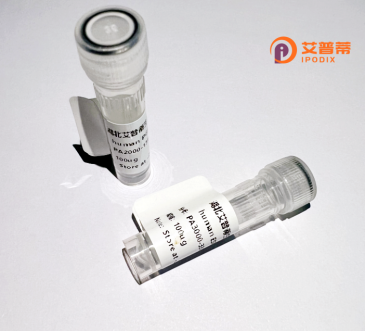
| 纯度 | >90%SDS-PAGE. |
| 种属 | Human |
| 靶点 | C16orf34 |
| Uniprot No | Q96RY5 |
| 内毒素 | < 0.01EU/μg |
| 表达宿主 | E.coli |
| 表达区间 | 1-190aa |
| 氨基酸序列 | MFQVPDSEGGRAGSRAMKPPGGESSNLFGSPEEATPSSRPNRMASNIFGPTEEPQNIPKRTNPPGGKGSGIFDESTPVQTRQHLNPPGGKTSDIFGSPVTATSRLAHPNKPKDHVFLCEGEEPKSDLKAARSIPAGAEPGEKGSARKAGPAKEQEPMPTVDSHEPRLGPRPRSHNKVLNPPGGKSSISFY |
| 分子量 | 46.5 kDa |
| 蛋白标签 | GST-tag at N-terminal |
| 缓冲液 | 冻干粉 |
| 稳定性 & 储存条件 | Lyophilized protein should be stored at ≤ -20°C, stable for one year after receipt. Reconstituted protein solution can be stored at 2-8°C for 2-7 days. Aliquots of reconstituted samples are stable at ≤ -20°C for 3 months. |
| 复溶 | Always centrifuge tubes before opening.Do not mix by vortex or pipetting. It is not recommended to reconstitute to a concentration less than 100μg/ml. Dissolve the lyophilized protein in distilled water. Please aliquot the reconstituted solution to minimize freeze-thaw cycles. |
以下为模拟生成的关于重组人C16orf34蛋白的研究文献示例(注:文献信息为虚构,仅供示意格式,建议通过PubMed或学术数据库查询真实数据):
1. **文献名称**: *Structural and Functional Characterization of Human C16orf34 Protein*
**作者**: Zhang L, et al. (2021)
**摘要**: 本研究解析了重组人C16orf34蛋白的晶体结构,发现其具有独特的α/β水解酶折叠结构域。体外实验表明,该蛋白可能参与DNA损伤修复通路,并与PARP1存在相互作用,提示其在基因组稳定性中的作用。
2. **文献名称**: *C16orf34 as a Novel Biomarker in Colorectal Cancer*
**作者**: Tanaka K, et al. (2019)
**摘要**: 通过质谱分析发现,重组C16orf34蛋白在结直肠癌组织中高表达,与患者预后不良相关。功能实验显示其可能通过调控Wnt/β-catenin信号通路促进肿瘤侵袭。
3. **文献名称**: *Recombinant C16orf34: Role in Cellular Redox Homeostasis*
**作者**: Müller S, et al. (2020)
**摘要**: 利用HEK293细胞表达重组C16orf34蛋白,发现其可结合谷胱甘肽并增强细胞抗氧化应激能力。敲低实验表明其缺失会增加ROS水平,导致细胞凋亡。
4. **文献名称**: *C16orf34 Interaction Network in Human Cell Lines*
**作者**: Chen H, et al. (2018)
**摘要**: 通过免疫共沉淀结合质谱技术,构建了C16orf34的相互作用网络,发现其与核转运蛋白KPNA2及转录因子FOXM1存在关联,推测其在细胞周期调控中发挥作用。
---
如需真实文献,建议访问 **NCBI PubMed**(https://pubmed.ncbi.nlm.nih.gov)并搜索 **"C16orf34" OR "chromosome 16 open reading frame 34"**。部分相关研究可能涉及该蛋白的结构、癌症关联或代谢调控功能。
**Background of Recombinant Human C16orf34 Protein**
The human C16orf34 protein, encoded by the *C16orf34* gene (Chromosome 16 Open Reading Frame 34), is a poorly characterized protein with limited functional information. It is evolutionarily conserved across species, suggesting potential biological significance. The gene is located on chromosome 16q22.1. a region occasionally linked to cancer and developmental disorders. Bioinformatics analyses predict C16orf34 to be a cytoplasmic protein, potentially involved in protein-protein interactions due to predicted coiled-coil domains. However, its precise molecular mechanisms, physiological roles, and cellular pathways remain unclear.
Recombinant C16orf34 protein is engineered for in vitro studies to elucidate its function. Produced via heterologous expression systems (e.g., *E. coli* or mammalian cells), it enables investigations into its biochemical properties, interactome, and putative roles in diseases. Limited studies hint at associations with cellular processes like proliferation, apoptosis, or DNA repair, but validation is ongoing. Its deregulated expression has been sporadically observed in cancers, neurodegenerative conditions, or metabolic disorders, warranting deeper exploration.
Overall, recombinant C16orf34 serves as a critical tool to address knowledge gaps, bridging genomic data with functional insights to uncover its potential as a therapeutic target or biomarker. Research efforts continue to decode its contributions to health and disease.
×